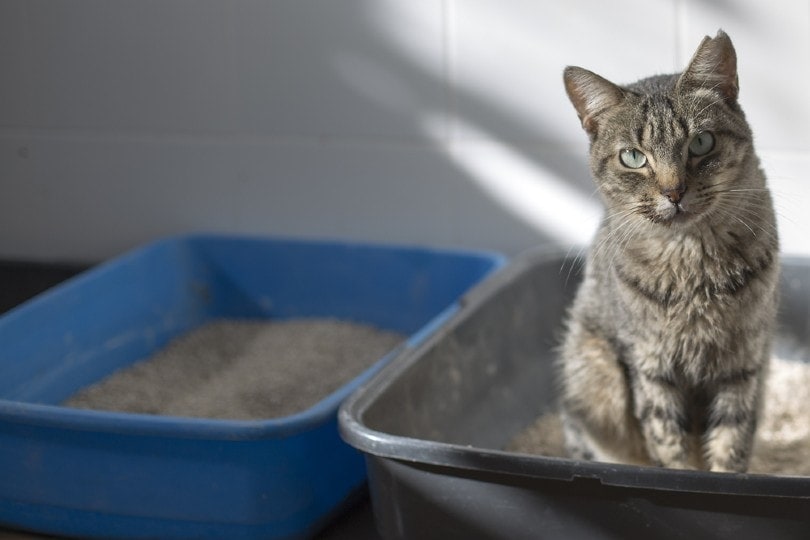
So, you found a stray and now you want to know if they can be in the house—fully litter trained. First of all, we commend you for taking in a homeless kitty to make sure they have a decent life. They surely appreciate it.
But before they get too comfy in their untamed ways, it’s nice to know how to handle the newcomer and their unique set of needs. Let’s talk about how to train this feline to have proper bathroom etiquette.
The 3 Potential Problems Found in Stray Cats

When you bring in a stray, it might not be a big deal if you don’t have other pets. However, some health issues are transmissible and some behaviors are spawned from territorial tendencies.
Let’s discuss some potential problems you could run into and some precautions to take.
Marking
If the stray is unaltered, whether male or female, they have the capability of spraying if they are over 6 months of age.
If you allow a stray to come in, they might start marking their territory or trying to attract a new mate in this newfound place.
If a cat is already spraying, even getting them fixed might not be a solution. Some cats continue the behavior even after they have the surgery.
However, as a precaution, you can use deterrent sprays and other products to prevent it. If it happens, you’ll have to get an odor neutralizer to put on the area.
Marking isn’t a bathroom issue, it is a behavior related to asserting dominance or scoring a mate. So, even with proper litter box habits, it can still crop up as an issue in strays.

Feline Leukemia
Feline leukemia is an incurable viral infection transmissible through sharing food, mating, and biting. Although some cats can live with this virus asymptomatic, it can wreak havoc on the cat’s immune system and easily pass to other felines.
Because it is such a concern to other cats in the home, sharing common spaces can be a bad idea until they’re tested—including litter boxes. A cat might look perfectly healthy but can still carry the virus in their system.
Symptoms of feline leukemia include:
When a cat is malnourished, it can be hard to distinguish the difference in symptoms between that and something more severe—like FeLV. You should always take the cat to a trusted vet right away to determine if the animal is positive or negative.
While it isn’t extremely common to pass this illness through shared litter boxes, it is still possible.
Parasites
Parasites are incredibly common among strays and pets alike. However, pets receive routine dewormers to get rid of any problematic parasites.
If you bring a stray into your home, they can transmit these parasites easily through waste. So, always make sure to pick up a dewormer. You can find options over the counter, at local rescues, or at your vet.
Your Trip to the Vet

To eliminate risks and fix any of the existing health issues, a vet visit should be first on your list. They can run simple blood tests to determine the general wellness of the feline. Once your stray has a clean bill of health, you can rest easy with the transitional part.
The 8 Steps for Training a Stray Cat to Use the Litter Box
Even though every cat will catch on at their own pace, here is a painless way to start the training process.
1. Limit Space
Before allowing the newcomer to free roam the home, you should limit their space to one room. You can choose a large kennel if you have one. Alternatively, you can pick a smaller room with hard floors so it’s easy to clean, avoiding carpet stains and messes.
This restriction can allow your cat to familiarize themselves with the home and help them adjust easily. Plus, they won’t be far from the litter box when they have to go. If an area is too big, they might resort to using the bathroom elsewhere if they can remember where to go.
2. Choose a Pellet Litter

When you’re starting the training process, getting a pellet-based litter might be better than small granules. These pellets are usually scentless, so your cat won’t be overwhelmed with strong fragrances.
Plus, the texture mimics more of what they would find outside. It’s coarse, natural, and encourages covering up their poop. Most of these litters are non-clumping, though. So be prepared for the cleaning involved.
Pellet-litters are also low-tracking, which helps when your cat is just getting into the swing of things. Flicking and tracking litter is very common with inexperienced felines.
3. Add Outdoor Matter
A really good way to show your cat where to go is to place some soil, leaves, or twigs into the box to help them make the distinction. If they are used to using old leaves and dirt to cover their waste, they will take to the box more if natural matter is inside.
You don’t have to use a ton—just a few pieces of the outdoors go a long way.
4. Make Sure the Box is Privatized

It’s a natural instinct for your cats to hide when they use the potty. Not out of modesty, of course, but to protect themselves from predators. So, when you have a cat in a brand-new environment, they might be extra skittish and cautious.
To ease them slowly into the process, make them feel protected. You can buy a hooded litter box, or simply make sure their space is totally private and noise-free.
5. Let the Kitty Sniff Around
When you introduce the cat, let them sniff around first. They can jump in and out of the box, checking it out. If they feel the textures and realize this is a desirable spot to do their business, they will follow suit.
They might not start using the litter box immediately, but this is a great way to get things started.
6. Offer the Litter Box After Naps and Meals

You should keep a close eye on when the stray wakes up and place them into the box. Or after eating, you should place the kitty into the box within 25 minutes of consumption.
If their digestive systems are on track, they will really need to go. Even though it might be tempting to free feed the cat because they are likely super hungry, routine feedings work better.
You will have more control over how to time when the cat goes to the bathroom.
7. Give Praise and Treats
What cat doesn’t like a good snack? Every time your new kitty uses the litter box, praise is key. You can reward them through high-pitched verbal tones, petting, and treats.
Cats do not respond well to negative punishments—especially one that is probably not used to people anyway. Try to avoid showing frustration for accidents, and instead, give lots of positive reinforcement for a job well done.
8. Have More Than One Box

Once your kitty seems to have gotten the concept down, you can start allowing access to more areas of the home. When you do so, offering more than one litter box is essential. That way, they have constant access.
Plus, in any case, you should always have two litter boxes per cat in the home.
Conclusion
Even though it might seem complicated initially, you should have a trained cat in no time—regardless of age.
Even if you are just a temporary caretaker, you are laying the foundation for their future home. It’s best to get started on litter training right after your stray gets a clean bill of health.
Featured Image Credit: Lightspruch, Shutterstock






